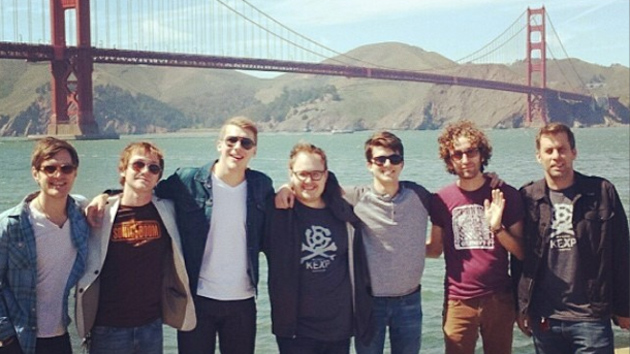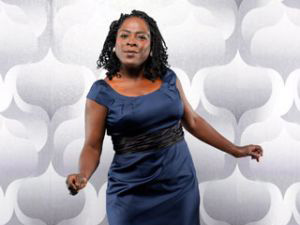
Next Big Sound cofounder Alex WhiteNext Big Sound
It was 8 p.m. on a Tuesday evening and the Chapel, a popular San Francisco venue, was already starting to fill. Young hipsters elbowed past the fogeys idling in back to stake out a prime spot on the floor. As soon as St. Paul and the Broken Bones hit the stage, though, the diverse crowd was transformed into a seamless sea of screaming fans, singing and swaying to the Birmingham, Alabama, band’s modern take on the soul sounds of yesteryear.
St. Paul’s rise has been unusually meteoric for a band that didn’t even exist until a year and a half ago. True, frontman Paul Janeway charms audiences between songs and delivers dance moves just awkward enough to be cool. And with Jesse Phillips on bass, Browan Lollar on guitar, Allen Branstetter on trumpet, Andrew Lee on drums, Ben Griner on trombone and tuba, and the well-known Al Gamble on keys, these guys know how to work a crowd. Even so, it was their first official tour, and here they were selling out weeknight shows on the other end of the country.

It all happened with lightning speed. In March, just after the release of their debut album, Half the City, St. Paul played at a South by Southwest showcase in Austin, Texas. A few days later, Rolling Stone proclaimed them one of the “48 Best Things” at the festival. Then came a review in the Guardian and an NPR story, followed by performances on CBS This Morning: Saturday and The Late Late Show With Craig Ferguson. Soon their album was No. 56 on the Billboard 200. “I think we are all genuinely surprised. We were just, we were taken aback by it,” Janeway told me. “It has been crazy. It has been a little—weird.”
Alex White could have predicted it. Actually, he did. White, 28, is the cofounder of a company called Next Big Sound (“Making data useful”), which, as its name and slogan imply, uses computer algorithms to determine which musical acts are about to take off.
Launched in 2009, and widely consulted by the mainstream music industry, the company crunches consumption data from social media and music-streaming sites, tracks buzz on Facebook, Twitter, SoundCloud, and YouTube, and collects private sales figures from clients and partners to inform its predictions. Its engineers and analysts—some of whom hail from data positions at Microsoft, the New York Yankees (think Moneyball), and the Department of Defense—compile everything into a ranking system.
The company’s Social 50 chart lists the internet’s most-talked-about acts—the Beyoncé’s of the world—while its Next Big Sound chart lists the hottest up-and-comers. St. Paul and the Broken Bones, as it happens, showed up at the top of the latter chart about a week before its March SXSW showcase. “I learned that we were No. 1 on something,” Janeway recalls with a full-bodied laugh. “And I thought, ‘Oh! We are No. 1 on something!'”
The guys didn’t think much of it, but it may well have kicked open some big doors for the band. Next Big Sound, first conceived by White when he was an undergraduate at Northwestern University, now provides data for 70 percent of the music industry. Competitors have followed its lead, looking to cash in on social-media metrics, but NBS’s paid subscribers range from the world’s biggest labels and distributors to hordes of individual artists and managers. The company is growing as quickly as some of the acts it lists. According to White, it’s on track to double its revenues this year.
White, who had worked previously with Universal Music Group, spotted his opportunity in the late aughts, as a new crop of music-steaming sites sprang up and CD sales continued to tank. “I think that everyone feels like they are very far behind in terms of their understanding and grasp of how to market successfully and analytically in this new world,” he says. “To boil it down, change has been the only constant over the last five years.”
What he was selling, really, was confidence. “We are making these predictions and drawing a line in the sand, saying these are the artists that are going to do really well,” Alec Zopf, one of the company’s software engineers, told me.
The various metrics are entered into a complex algorithm that quantifies an artist’s fan growth and social interactions to determine who is resonating most with their audiences. It’s not purely objective. The inputs are weighted according to analysts’ knowledge of industry trends and historic patterns of artistic success. “It is sort of a mix of art and science,” Zopf explains, one that combines calculation, curation, and strategic analysis.
But somewhere along the line, Next Big Sound has become something more than a data-cruncher for music marketers. In true Heisenbergian fashion, its algorithms have begun to affect outcomes by changing the way labels track artists and make decisions. In short, the company is becoming a hitmaker itself. “Measurement is never neutral,” notes Nancy Baym, who studies social media metrics at Microsoft Research and has authored several papers on the topic. “The way you measure things shapes the way you think about what you’re measuring. It shapes the way you approach it. It shapes the kinds of materials that you create.”
White acknowledges as much. He often hears from managers and artists who have been approached with record deals, publishing contracts, and higher tiers of management after appearing on his company’s charts. “I think there is sort of a feedback mechanism that has started.”
“In some ways it helps shape trends more than it helps predict them,” says Jason Feinberg, the VP of digital strategy for Epitaph Records, one of America’s biggest indie labels, who has been using Next Big Sound for years. “I don’t think any of these tools have really gotten far enough along to predict much.” Feinberg says he mostly uses the platform to see how artists are doing in particular regions, or to answer specific questions: Say a band’s numbers “spike out of nowhere where we weren’t doing a heavy marketing campaign, or there wasn’t a TV appearance, anything like that,” he says. “Looking for what causes that is often something these tools can show you.”
Baym points out that search engines and social media can be gamed—likes and follows are easily purchased. Next Big Sound’s data analysts are well aware of it, says engineer Zopf. They scour the data for irregularities and do their best to weed out any phony fans. They also regularly tweak the magic formula to account for what’s hot in social media—and what’s not. SoundCloud, for instance, has gained clout in the algorithm recently, whereas MySpace (remember MySpace?) continues to languish.
There are other pitfalls, though, to relying on social-media buzz and other online interactions to identify consumer trends. “You have to think about who is participating in those systems in the first place,” Baym says. “There are a lot more people lurking and not ‘liking,’ and not actively discussing things at any given time. So it is always going to be kind of skewed, because you are not tapping who is singing along really loud in their car.”
The data also tends to be slanted toward those genres whose fans are most active on the internet, such as EDM (electronic dance music), which is consumed and shared almost entirely online, especially in Europe. “The less that a genre has consumers that interact online and are able to be measured, the less effective the software is,” White concedes. “Classical and jazz, we have strong coverage of those artists, but there isn’t a lot of volume on YouTube and Spotify.”
Sachin Doshi, the head of development and analysis at Spotify, concurs: “Our genre spectrum is a little bit different than the average across the population,” he says. “When Spotify is growing in a particular market, we get early adopters first. Things like EDM over-index, especially early on.”
And, of course, younger audiences are the most inclined to engage online, regardless of genre. “Watching a video, looking at a photo, listening to a song—simple engagement is starting to happen across all demographics,” says Epitaph’s Feinberg. “But when it comes to heavy engagement—entering contests, creating content, things like that—certainly younger demographics.”
This makes Next Big Sound attractive to corporate clients outside of the music industry who are eager to tap into the youth market—NBS signed its first Fortune 50 brand deal last fall and is ramping up that end of the business. “Brands recognize that it is a great way to attract their target customer,” White says. “I think it’s a great opportunity for our existing customers to measure and engage and work with artists that really resonate in the marketplace.”
Yet “there is a downside to the belief that the data is a crystal ball, or that by having this data we suddenly now can learn things that we have never known before,” Feinberg says. “As much as I am a believer in this, I think the downside is when people rely too heavily on it for something they don’t know, or jump to conclusions based on just a small subset of data.”
To be sure, labels that channel their investments toward artists with social media savvy run the risk of putting sales tactics ahead of talent. Mike King, a marketing lecturer at the online branch of Berklee College of Music in Boston, told me he would like to see labels use the data to help great acts move up organically, as opposed to shoving the chosen few down our throats from on high. “The goal will be the right consumer hearing about the right music through the right outlets at the right time,” he says. “I am hoping that marketers can interpret the data and say, ‘Here is where the core fans are for this particular artist, and we are going to reach out with the right content on the right platform.'”
Feinberg agrees, adding that the data needs to be interpreted by people who understand the artistic landscape. “You can’t just look at it and make decisions based on it,” he says. “You have to mix it in with all the other data you have, as well as all the expertise of the people in the room. Then you have something useful.”
Either way, these sorts of metrics are only going to become more common throughout the business world. “It will always be flawed, especially in culture industries, and there will be conflicts between the sense that these are really helpful predictors because they do provide some economic security, supposedly,” Baym says. “On the other hand, there’s the people who are saying you are taking all the art out of it.”
St. Paul and the Broken Bones is just happy to be playing for an enthusiastic audience, which stomps its feet and chants for more even after the band’s third encore. It’s late, though, and the lads have a long drive to Los Angeles ahead. Before leaving the stage, each member takes a bow. One snaps a picture of the cheering crowd for the band’s Instagram. Fans demand attention, after all, and St. Paul is happy to oblige. “The internet and social media is the best thing that has happened, because it is the judge. It tells you; the people are going to tell you,” Janeway says. “That puts it back into the people’s hands a little bit.”















